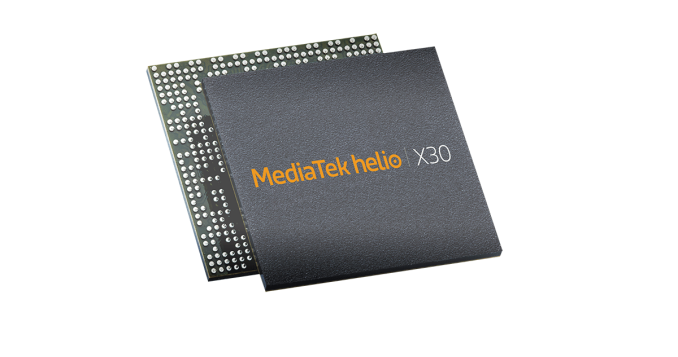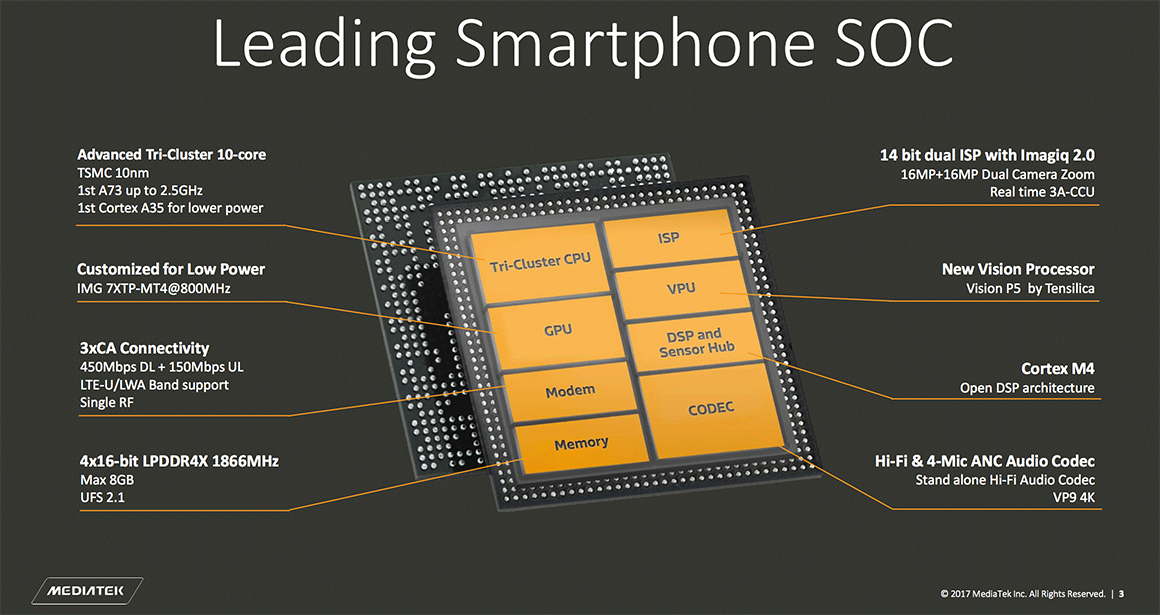MediaTek Announces Helio X30 Availability: 10 CPU Cores On 10nm
by Matt Humrick on February 27, 2017 8:35 PM EST- Posted in
- Smartphones
- Mobile
- Trade Shows
- SoCs
- MediaTek
- Helio
- MWC_2017
- Helio X30

MediaTek first unveiled the Helio X30—its next-generation high-end SoC—last fall, but today at Mobile World Congress the Taiwanese company announced its commercial availability. The Helio X30 is entering mass production and should make its debut inside a mobile device sometime in Q2 2017.
The Helio X30, like the Helio X20 family before it, incorporates 10 CPU cores arranged in a Max.Mid.Min tri-cluster configuration. Two of ARM’s latest A73 CPU cores replace the two A72s in the Max cluster, which should improve performance and reduce power consumption. The Mid cluster still uses 4 A53 cores, but they receive a 10% frequency boost relative to the top-of-the-line Helio X27. In the X30’s Min cluster we find the first implementation of ARM’s most-efficient A-series core. The A35 consumes 32% less power than the A53 it replaces (same process/frequency), while delivering 80%-100% of the performance, according to ARM. With a higher peak frequency of 1.9GHz, the X30’s A35 cores should deliver about the same or better performance than the X20’s A53 cores and still consume less power.
| MediaTek Helio X20 vs. Helio X30 | ||
| SoC | MediaTek Helio X20 |
MediaTek Helio X30 |
| CPU | 2x Cortex-A72 @2.1GHz 4x Cortex-A53 @1.85GHz 4x Cortex-A53 @1.4GHz |
2x Cortex-A73 @2.5GHz 4x Cortex-A53 @2.2GHz 4x Cortex-A35 @1.9GHz |
| GPU | ARM Mali-T880MP4 @780MHz |
PowerVR 7XTP-MT4 @800MHz |
| Memory Controller |
2x 32-bit @ 933MHz LPDDR3 14.9GB/s b/w |
4x 16-bit @ 1866MHz LPDDR4x 29.9GB/s b/w |
| Video Encode/ Decode |
encode: 2160p30 H.264 / HEVC w/HDR decode: 2160p30 10-bit H.264 / HEVC / VP9 |
encode: 2160p30 H.264 / HEVC w/HDR / VP9 decode: 2160p30 10-bit H.264 / HEVC / VP9 |
| Camera/ISP | Dual ISP 32MP @ 24fps (single camera) or 13MP + 13MP @ 30fps (dual camera) |
Dual 14-bit ISP 28MP @ 30fps (single camera) or 16MP + 16MP (dual camera) |
| Integrated Modem |
LTE Category 6 DL = 300Mbps 2x20MHz CA, 64-QAM UL = 50Mbps 1x20MHz CA, 16-QAM FDD-LTE / TD-LTE / TD-SCDMA / WCDMA / CDMA / GSM |
LTE Category 10 DL = 450Mbps 3x20MHz CA, 64-QAM UL = 150Mbps 2x20MHz CA, 64-QAM FDD-LTE / TD-LTE / TD-SCDMA / WCDMA / CDMA / GSM |
| Mfc. Process | TSMC 20SoC (planar) | TSMC 10nm FinFET |
The Helio X30 will also be the first SoC to use TSMC’s 10nm process, which will offer significant power savings relative to TSMC’s 20nm planar process that the Helio X20 family uses. According to MediaTek, the X30 consumes 50% less power than the X20 when running an unspecified CPU workload and 60% less power when running GFXBench T-Rex. These power savings will increase battery life and improve sustained performance with less thermal throttling.
Alongside the Helio X30, MediaTek is launching CorePilot 4.0, which manages CPU frequency and task scheduling. Optimized for its unique tri-cluster CPU configuration, CorePilot keeps track of the SoC’s power budget by monitoring temperature, and the global task scheduler component is responsible for migrating tasks between clusters based on workload and user experience parameters, such as frames per second. It also adjusts CPU frequency using Fast DVFS technology that increases sampling rate, allowing for faster voltage/frequency adjustments that better follow changes in workload. The overall goal of CorePilot 4.0 is to achieve the best possible performance at the lowest power levels.
In a short presentation at its MWC booth Monday, Executive Vice President & Co-COO Jeffrey Ju stated that MediaTek expects only a limited number of phones to use the Helio X30, perhaps less than ten. He also mentioned that a low yield rate for TSMC’s 10nm process has delayed the X30’s availability. The X30 sounds compelling on paper, so it will be interesting to see how many design wins it can actually achieve.











57 Comments
View All Comments
kenansadhu - Monday, February 27, 2017 - link
Are they the only one releasing an actual A73 core at 10nm process? It is possible that this will actually be faster than the custom cores (or slightly slower at significantly lower price). I hope the GPU will be good enough though, any concrete news on the GPU?Arch_Fiend - Monday, February 27, 2017 - link
For now they are the only ones, Huawei's HiSilicon is apparently launching an K970 chip sometime this year that will also be produced on TSMC's 10mm process and have A73 cores. Hopefully it will have a high core count than 8 for it's Mali G71 GPU as well.fm13 - Tuesday, February 28, 2017 - link
no: https://www.gizmochina.com/2017/02/24/xiaomi-pinec...MrSpadge - Tuesday, February 28, 2017 - link
Of course the GPU will be "good enough" for most users most of the time - or what do you think people are doing with their phones where they're bottlenecked by the GPU performance?Mil0 - Wednesday, March 1, 2017 - link
Gaming.Lodix - Wednesday, March 1, 2017 - link
The GPU will be a bit behind the Adreno 530 in the SD820 so it is not bad. And from the numbers given by MTK it could be more efficient so more battery life while gaming and less throttling.Krysto - Thursday, March 9, 2017 - link
GPU is a little disappointing, not because it's PowerVR, but because it's an older PowerVR. It's a little frustrating to see that MediaTek moved away from Mali just when Mali got good, after keeping the bad Mali GPUs for so many years.However, I have the feeling that they did this on purpose, as a "compromise" that allowed them to have potentially one of the fastest mobile CPUs on the market - Cortex-A73 on 10nm should give very high performance, potentially even higher than the Snapdragons. We'll see, either way it should be very close.
If this is the compromise they had to make to keep their chips a lower price, I'm okay with that. It's better to have top of the line CPU and a less than top of the line GPU for the position they are in right now in the market.
Perhaps in a generation or two, they'll be able to have the fastest CPU as well as the fastest GPU, while on the most cutting edge process. But for now, I'm actually quite impressed with the chip. Cortex-A73 and A35 at 10nm should do wonders for efficiency. If I were them I would've probably gotten rid of the A53, though. Not sure what's their purpose there. Was a "mid-step" in performance really necessary there? I kind of doubt it.
lagittaja - Thursday, March 9, 2017 - link
What would you rather they use from the PowerVR line in place of the Series7XTP?Series8XE? Nope, not as powerful.
Series8XE Plus? Nope, not as powerful.
Series8XT? Nope, the Furian architecture was announced just two days ago. It's impressive but too new, remember, Mediatek unveiled the Helio X30 last fall...
Also API's wise the Series8XE/XEP don't offer anything special over the Series7XTP and the Furian is still so new and I'm too tired to do further research on it so don't know if it has some magical unicorns the 7XTP doesn't have.
Nevertheless, Rogue is still a really good GPU arch in my opinion.
Meteor2 - Tuesday, March 14, 2017 - link
He said he'd rather they stuck with Mali.zeeBomb - Monday, February 27, 2017 - link
So uh, which phone will have this?